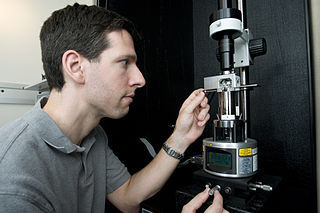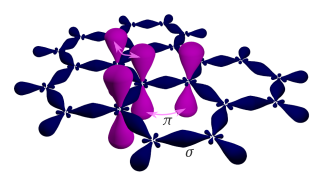Related Research Articles

In physics, dephasing is a mechanism that recovers classical behaviour from a quantum system. It refers to the ways in which coherence caused by perturbation decays over time, and the system returns to the state before perturbation. It is an important effect in molecular and atomic spectroscopy, and in the condensed matter physics of mesoscopic devices.
Quantum Monte Carlo encompasses a large family of computational methods whose common aim is the study of complex quantum systems. One of the major goals of these approaches is to provide a reliable solution of the quantum many-body problem. The diverse flavors of quantum Monte Carlo approaches all share the common use of the Monte Carlo method to handle the multi-dimensional integrals that arise in the different formulations of the many-body problem.

SIESTA is an original method and its computer program implementation, to efficiently perform electronic structure calculations and ab initio molecular dynamics simulations of molecules and solids. SIESTA uses of strictly localized basis sets and from the implementation of linear-scaling algorithms. Accuracy and speed can be tuned in a wide range, from quick exploratory calculations to highly accurate simulations matching the quality of other approaches, such as plane-wave and all-electron methods.

The atomic de Broglie microscope is an imaging system which is expected to provide resolution at the nanometer scale. It is sometimes referred to as a "nanoscope."

Spartan is a molecular modelling and computational chemistry application from Wavefunction. It contains code for molecular mechanics, semi-empirical methods, ab initio models, density functional models, post-Hartree–Fock models, and thermochemical recipes including G3(MP2) and T1. Quantum chemistry calculations in Spartan are powered by Q-Chem.
Atomistix Virtual NanoLab (VNL) is a commercial point-and-click software for simulation and analysis of physical and chemical properties of nanoscale devices. Virtual NanoLab is developed and sold commercially by QuantumWise A/S. QuantumWise was then acquired by Synopsys in 2017.

A quantum point contact (QPC) is a narrow constriction between two wide electrically conducting regions, of a width comparable to the electronic wavelength.
Atomistix A/S was a software company developing tools for atomic scale modelling. It was headquartered in Copenhagen, Denmark, with a subsidiary for Asia Pacific in Singapore and for the Americas in California. In September 2008 Atomistix A/S went bankrupt, but in December 2008 the newly founded company QuantumWise announced that they had acquired all assets from the Atomistix estate and would continue the development and marketing of the products Atomistix ToolKit and Atomistix Virtual NanoLab. QuantumWise was then acquired by Synopsys in 2017.
Car–Parrinello molecular dynamics or CPMD refers to either a method used in molecular dynamics or the computational chemistry software package used to implement this method.
A charge density wave (CDW) is an ordered quantum fluid of electrons in a linear chain compound or layered crystal. The electrons within a CDW form a standing wave pattern and sometimes collectively carry an electric current. The electrons in such a CDW, like those in a superconductor, can flow through a linear chain compound en masse, in a highly correlated fashion. Unlike a superconductor, however, the electric CDW current often flows in a jerky fashion, much like water dripping from a faucet due to its electrostatic properties. In a CDW, the combined effects of pinning and electrostatic interactions likely play critical roles in the CDW current's jerky behavior, as discussed in sections 4 & 5 below.
Inelastic electron tunneling spectroscopy (IETS) is an experimental tool for studying the vibrations of molecular adsorbates on metal oxides. It yields vibrational spectra of the adsorbates with high resolution (< 0.5 meV) and high sensitivity (< 1013 molecules are required to provide a spectrum). An additional advantage is the fact that optically forbidden transitions may be observed as well. Within IETS, an oxide layer with molecules adsorbed on it is put between two metal plates. A bias voltage is applied between the two contacts. An energy diagram of the metal-oxide-metal device under bias is shown in the top figure. The metal contacts are characterized by a constant density of states, filled up to the Fermi energy. The metals are assumed to be equal. The adsorbates are situated on the oxide material. They are represented by a single bridge electronic level, which is the upper dashed line. If the insulator is thin enough, there is a finite probability that the incident electron tunnels through the barrier. Since the energy of the electron is not changed by this process, it is an elastic process. This is shown in the left figure.
Subir Sachdev is Herchel Smith Professor of Physics at Harvard University specializing in condensed matter. He was elected to the U.S. National Academy of Sciences in 2014, and received the Lars Onsager Prize from the American Physical Society and the Dirac Medal from the ICTP in 2018. He was a co-editor of the Annual Review of Condensed Matter Physics from 2017-2019.

A trojan wave packet is a wave packet that is nonstationary and nonspreading. It is part of an artificially created system that consists of a nucleus and one or more electron wave packets, and that is highly excited under a continuous electromagnetic field.
Yambo is a computer software package for studying many-body theory aspects of solids and molecule systems. It calculates the excited state properties of physical systems from first principles, e.g., from quantum mechanics law without the use of empirical data. It is an open-source software released under the GNU General Public License (GPL). However the main development repository is private and only a subset of the features available in the private repository are cloned into the public repository and thus distributed.
Valleytronics is an experimental area in semiconductors that exploits local extrema ("valleys") in the electronic band structure. Certain semiconductors have multiple "valleys" in the electronic band structure of the first Brillouin zone, and are known as multivalley semiconductors. Valleytronics is the technology of control over the valley degree of freedom, a local maximum/minimum on the valence/conduction band, of such multivalley semiconductors.

Interatomic potentials are mathematical functions to calculate the potential energy of a system of atoms with given positions in space. Interatomic potentials are widely used as the physical basis of molecular mechanics and molecular dynamics simulations in computational chemistry, computational physics and computational materials science to explain and predict materials properties. Examples of quantitative properties and qualitative phenomena that are explored with interatomic potentials include lattice parameters, surface energies, interfacial energies, adsorption, cohesion, thermal expansion, and elastic and plastic material behavior, as well as chemical reactions.
Ramamurti Rajaraman is an Emeritus Professor of Theoretical Physics at the School of Physical Sciences at Jawaharlal Nehru University. He was also the co-Chairman of the International Panel on Fissile Materials and a member of the Bulletin of the Atomic Scientists' Science and Security Board. He has taught and conducted research in physics at the Indian Institute of Science, the Institute for Advanced Study at Princeton, and as a visiting professor at Stanford, Harvard, MIT, and elsewhere. He received his doctorate in theoretical physics in 1963 from Cornell University. In addition to his physics publications, Rajaraman has written widely on topics including fissile material production in India and Pakistan and the radiological effects of nuclear weapon accidents.

Graphene is a semimetal whose conduction and valence bands meet at the Dirac points, which are six locations in momentum space, the vertices of its hexagonal Brillouin zone, divided into two non-equivalent sets of three points. The two sets are labeled K and K'. The sets give graphene a valley degeneracy of gv = 2. By contrast, for traditional semiconductors the primary point of interest is generally Γ, where momentum is zero. Four electronic properties separate it from other condensed matter systems.
The FLEUR code is an open-source scientific software package for the simulation of material properties of crystalline solids, thin films, and surfaces. It implements Kohn-Sham density functional theory (DFT) in terms of the all-electron full-potential linearized augmented-plane-wave method. With this, it is a realization of one of the most precise DFT methodologies. The code has the common features of a modern DFT simulation package. In the past, major applications have been in the field of magnetism, spintronics, quantum materials, e.g. in ultrathin films, complex magnetism like in spin spirals or magnetic Skyrmion lattices, and in spin-orbit related physics, e.g. in graphene and topological insulators.
References
- ↑ "QuantumATK Atomic-Scale Modeling for Semiconductor & Materials".
- ↑ "Synopsys Strengthens Design-Technology Co-Optimization Solution with Acquisition of QuantumWise".
- ↑ Brandbyge, Mads; Mozos, José-Luis; Ordejón, Pablo; Taylor, Jeremy; Stokbro, Kurt (2002). "Density-functional method for nonequilibrium electron transport". Physical Review B. 65 (16): 165401. arXiv: cond-mat/0110650 . Bibcode:2002PhRvB..65p5401B. doi:10.1103/PhysRevB.65.165401. S2CID 44943573.
- ↑ Taylor, Jeremy; Guo, Hong; Wang, Jian (2001). "Ab initiomodeling of quantum transport properties of molecular electronic devices". Physical Review B. 63 (24): 245407. Bibcode:2001PhRvB..63x5407T. doi:10.1103/PhysRevB.63.245407. hdl: 10722/43343 .
- ↑ Soler, José M.; Artacho, Emilio; Gale, Julian D.; García, Alberto; Junquera, Javier; Ordejón, Pablo; Sánchez-Portal, Daniel (2002). "The SIESTA method forab initioorder-Nmaterials simulation". Journal of Physics: Condensed Matter. 14 (11): 2745–2779. arXiv: cond-mat/0104182 . Bibcode:2002JPCM...14.2745S. doi:10.1088/0953-8984/14/11/302. S2CID 250812001.